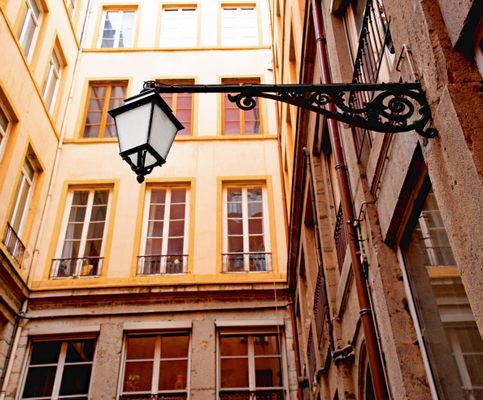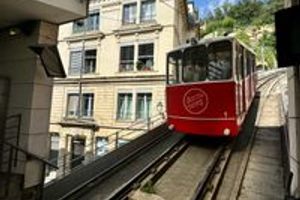About
Between courtyards and through buildings, secret alleyways and staircases once provided safe and efficient passage for silk workers to get their wares to and from market unmarred. Now partially open to the public, many of the traboules worm through several buildings forming a secret continuous covered passageway.
The word traboules is a corruption of the Latin trans-ambulare, meaning "to pass through," and the earliest date from the 4th century, built to allow more direct access to the town's fresh water source than the winding streets provided. There may be as many as 400 traboules in town—unfortunately only a small percentage of them are open to the public, mostly located primarily in the historic Vieux-Lyon and the Pentes de la Croix-Rousse areas.
The Croix-Rousse district of Lyon was the heart of the 19th century silk trade, and the courtyards and traboules that pass through it were the meeting places for the local "Canut" silk weavers. In the 1830s there were as many as 25,000 silk looms in Lyon, and as more silk workshops opened, merchants began to take advantage of the artisan class weavers with reduced wages and benefits. Struggling with the combination of increased competition, new technology, uncertain economic forces and the extortionate merchants, the workers rose up twice in dramatic rebellions. The workers banded together, closed workshops and marched on the town, picking up weapons at the armory as they went, seeking to hold the industry hostage until a set wage was agreed to. However, the revolts were bloodily suppressed. 10,000 Canuts reportedly were tried in Paris and faced criminal deportation, but their motto of "live free working or die fighting" inspired other workers uprisings in future years.
The publicly accessible traboules are clearly marked with a small identifying seal. Private passages are behind locked doors or gates. In the 1990s the Lyon Department of Urban Planning started a program of restoration and maintenance to encourage public access to the historic passages.
The longest traboule in Lyon runs between 54 Rue Saint-Jean and 27 Rue du Bœuf, and a famously picturesque traboule begins at 9 Place Colbert/14 bis montee Saint Sebastion, and features a historic six-story external staircase.
Related Tags
Know Before You Go
For the Canut workshops and traboules: Meeting place - Place de la Croix-Rousse, in the 4th district, underground station Croix-RousseFor the Vieux-Lyon traboules: Meeting place - Tourist Office, Place Bellecour, in the 2nd district. For navigating the traboules the Croix-Rousse, follow the arrows accompanied by the lion's head. In Vieux-Lyon, these passageways are marked by a bronze shield.
Community Contributors
Added By
Published
December 11, 2009
Sources
- Ville de Lyon: Official site
- http://www.lyon.fr/vdl/sections/en/urbanisme/cours_traboules_lyon
- Rhone-Alps Tourism: Tour of Lyon Traboules and visitor information
- http://www.rhonealpes-tourisme.com/articles/lyon/architecture/history/the-amazing-tour-in-the-traboules-of-lyon-394-1.html
- Self guided tours of Trabules, with maps (in French)
- http://www.lyontraboules.net/


















































